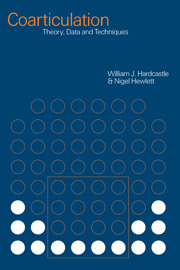Book contents
- Frontmatter
- Contents
- List of figures
- List of tables
- List of contributors
- Acknowledgments
- Introduction
- Part I Theories and models
- Part II Research results: components of the motor system for speech
- Part III Wider perspectives
- Part IV Instrumental techniques
- 10 Palatography
- 11 Imaging techniques
- 12 Electromagnetic articulography
- 13 Electromyography
- 14 Transducers for investigating velopharyngeal function
- 15 Techniques for investigating laryngeal articulation
- 16 Acoustic analysis
- References
- Index
14 - Transducers for investigating velopharyngeal function
Published online by Cambridge University Press: 22 September 2009
- Frontmatter
- Contents
- List of figures
- List of tables
- List of contributors
- Acknowledgments
- Introduction
- Part I Theories and models
- Part II Research results: components of the motor system for speech
- Part III Wider perspectives
- Part IV Instrumental techniques
- 10 Palatography
- 11 Imaging techniques
- 12 Electromagnetic articulography
- 13 Electromyography
- 14 Transducers for investigating velopharyngeal function
- 15 Techniques for investigating laryngeal articulation
- 16 Acoustic analysis
- References
- Index
Summary
Introduction
In phonetic and clinical research, the study of velopharyngeal function has received considerable attention during the past decades and in both domains numerous instrumental techniques have been used either singly or in combination. The techniques employed for collecting physiological, acoustical and aerodynamic data about speech sounds have been described by Abbs and Watkin (1976) in phonetic research and by Baken (1998) in clinical research. The most complete survey of the instrumental techniques used for the investigation of nasalization and velopharyngeal function has been published by Krakow and Huffman (1993) with critical comments on their respective advantages and limitations.
As a result of intensive work carried out by means of these devices, valuable information on nasal sounds has been obtained. However, because of factors such as invasiveness, discomfort, limitations or expense, these techniques have proved useful in one specific domain of research, but not necessarily in others.
In the following sections, two types of instrumental techniques will be distinguished:
the first type concerns indirect observation techniques such as aerometry, electromyography and acoustics;
the second type concerns direct observation techniques such as radiography, endoscopy, photodetection, mechanical devices and more recent techniques such as ultrasound, magnetic resonance imaging and electromagnetic articulometry.
Indirect observation techniques
Aerometry
To gain insight into the aerodynamics associated with nasalization (Warren, Dalston and Mayo 1993), various devices have been designed for measuring oral and nasal airflow.
- Type
- Chapter
- Information
- CoarticulationTheory, Data and Techniques, pp. 284 - 293Publisher: Cambridge University PressPrint publication year: 1999
- 1
- Cited by



